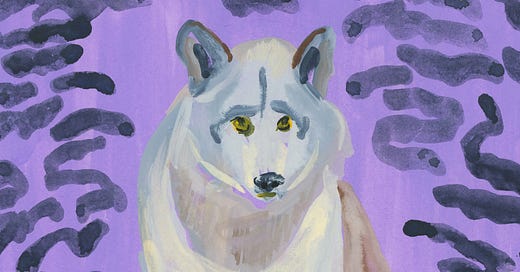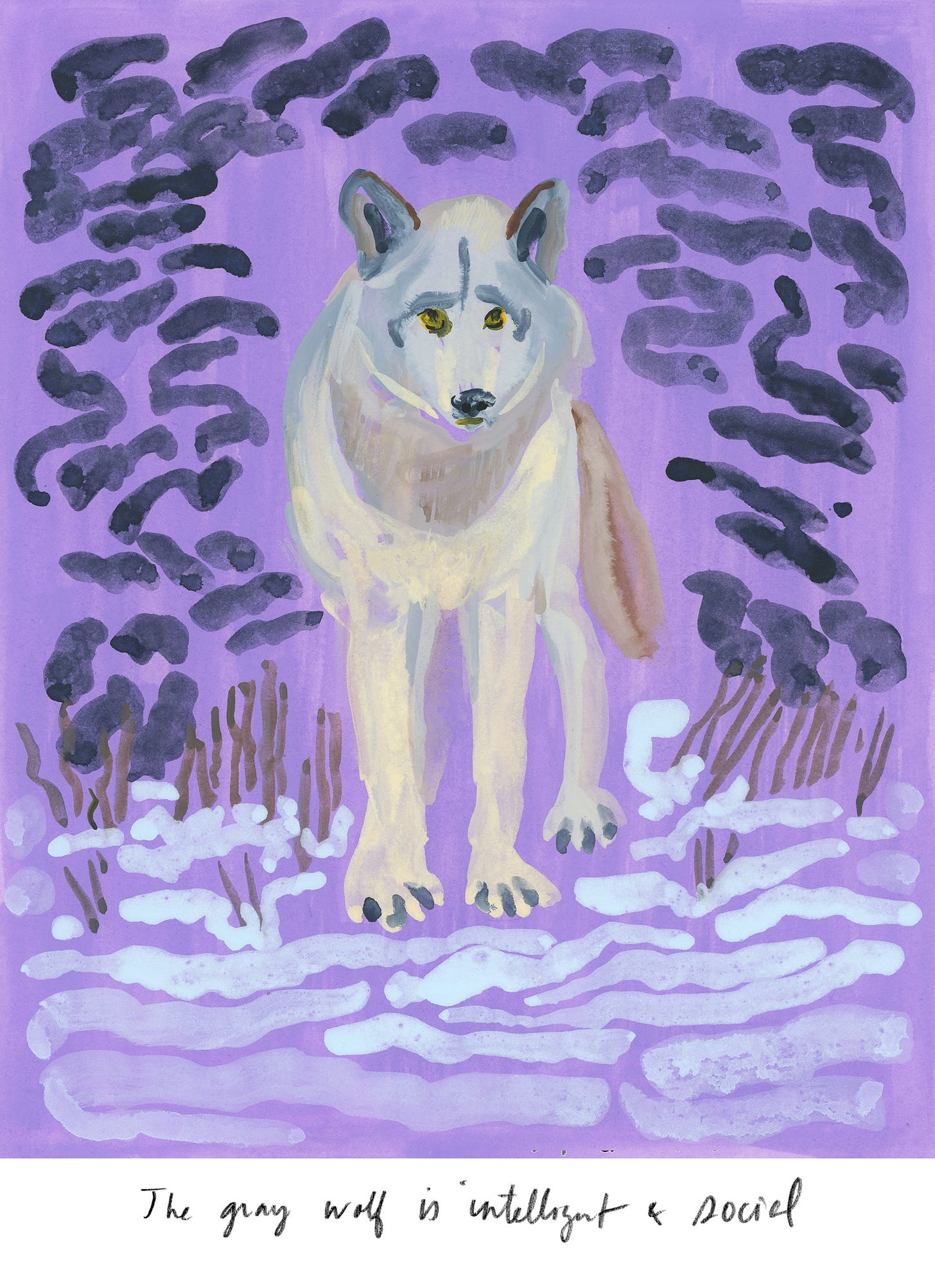Hi, friends — welcome to issue #11 of my newsletter about animal encounters. If anyone has seen a gray wolf (Canis lupus) in the wild, please let me know, I’m so curious. You’re always welcome to reply directly, or comment on the website. Thanks! — Amy Jean
Wolves once roamed North America in the hundreds of thousands. Perhaps you would have seen them, before the arrival of European settlers, or, more likely, you would have heard them. Take a minute to listen to a chorus here.
Each wolf has its own distinctive howl. They call to each other for various reasons, at times discordant, at times harmonizing. Many animals vocalize in frequencies beyond our perception, so when a creature shares the same auditory space as us, with such complexity, it is a remarkable connection. You can listen to another chorus here.
Honestly I could listen to them forever, sitting here on my couch, late at night, with my grumbling dog beside me. Speaking of which, domestic dogs share a common ancestor with the gray wolf, diverging around 15,000 to 40,000 years ago. (The domestication of dogs—or, I like to think, their domestication of us—is a foundational story in the history of human beings.)
Wolves do not howl at the moon, but they can be vocal at night, and so one of the names for January’s full moon (outside my window now) is the Full Wolf Moon. It fits poetically in my mind—but I can’t imagine what it must have felt like to hear them in their element, on a bright night like tonight.
Wolves were extirpated in the lower 48 states by the 1940s. They are carnivores and will attack domestic animals, if food is scarce. This of course is the source of the conflict, but they didn’t deserve to be devastated. We killed gray wolves indirectly, taking their habitats and food sources (bison and elk), and we killed them directly, often for sport, awarding hunting bounties, and by poisoning them, too.
As if that weren’t enough, we filled our stories with villainous versions of them. Europe had similarly cleared its lands of wolves and scared its children with tales of the Big Bad Wolf, for example. They were demonized, and so the gray wolf had no chance really.
Of course, in truth, wolves are not villains—and not everyone’s stories consider them as such. Indigenous peoples across North America understand them in a much richer light. The Ojibwe consider the wolf, “Ma’iingan,” a guide and protector, “the one put here by that All Loving Spirit to show us the way.” Wolves are recognized as keen, cooperative hunters who form tight social bonds (not unlike us).
Gray wolves are intelligent, social creatures, who are generally shy of humans. It is unusual to see them, even in the northern ranges where they remain extant. Wolves live together in packs, usually small family groups of around 8 individuals, though they can be larger, up to 20 or more, depending on the food sources available to them.
A wolf pack will protect its territory, which can be anywhere from 100 to 1,000 square miles, again depending on the region and availability of prey. The parents, who mate for life, are in charge. (The idea of the “alpha” is no longer in use, since the pair did not compete for their position; they are more accurately the breeding pair—the parents.)
In the last twenty years, there have been efforts to reintroduce the gray wolf in selective areas—most notably at Yellowstone. It has been one of the more positive conservation stories, as their numbers have grown, and also fascinating for the wolves’ positive effect on the landscape and ecosystem.
As wolves culled the number of elk in Yellowstone and shifted these animals’ grazing habits, small trees and vegetation returned, creating more food sources and habitats for smaller animals. The wolves, perhaps counterintuitively, have also helped stabilize and strengthen the elk herd, making them more able to survive drought and the pendulum swings of climate change. It turns out the world of Yellowstone needed wolves.
Is there a version of the larger world in which humans and wolves live alongside? Can we design our infrastructure and architecture to facilitate shared habitats and diversity? This may seem a distant dream to us now, but perhaps we can imagine it. The simple act of telling new stories, of seeing these creatures in a new light—replacing fear with knowledge—is a beginning.
Gray wolf links—
Take your pick of "wolves howling in a winter wonderland" or, my favorite, "the funniest wolf howls are lazy ones" from the Wolf Conservation Center [YouTube]
“25 years after returning to Yellowstone, wolves have helped stabilize the ecosystem” — this article explains it all. There’s a video toward the end that includes a fascinating chase (elk are no dummies either). [National Geographic]
Last year, gray wolves were controversially taken off the endangered species list in the continental United States, returning management to the state level. [NPR]
A student at the Northome School in Minnesota presents the Ojibwe word of the day, Ma'iingan [YouTube]
"It is a gift to have an encounter with Ma'iingan" the documentary Ma'iingan: Brother Wolf considers the spiritual connection between Ojibwe people and the wolf, as well as efforts to bring wolves back to to the land, tracking and protecting them. It is available online as part of a fundraising drive for PBS Wisconsin (but you can easily skip those parts). Beginning at about 44:05 the dynamic of the wolf as villain is considered and powerfully refuted.
If you enjoy beautiful, hand-drawn, thoughtful animation, you will enjoy the movie Wolfwalkers by Cartoon Saloon (streaming on AppleTV; here’s the trailer). Kids will love it, too. I’m such a fan of Cartoon Saloon I would happily hop on a plane to their studio in Kilkenny, Ireland, to draw blades of grass.
River otter encounters—
Thank you for sending in your river otter stories: They’re on the sidewalk outside the art store on Vancouver Island. They’re “basically one huge muscle with big teeth and hop right up on the dock.” They’re in the Hudson Valley, and may or may not be at Rock Creek Park in DC.
Also—
Next week I’m thinking about mourning doves, who sometimes appear out of every window. Or, maybe the snowy owl, in the news.
My wolf drawing is for sale; please reply if you’re interested. I’ll send some of the proceeds to the International Wolf Center.
Thanks for reading! Please share with friends and family who would enjoy. This newsletter is a weekly adventure about the life around us.





I’ve encountered wolves twice, a few days apart. The first I spied as he loped across the road in northern British Columbia. I pulled over and strained my eyes, searching the low brush for him, but he’d vanished like a wisp.
A couple days later, we set up camp by headlight in a blowing mix of snow and sleet. It was September, and we were the only folks in the campground. I have never been so cold. Burrowed into my sleeping bag, I finally warmed up and started to drift to sleep.
I felt the sound, deep below my sternum, before I heard it. And I was on my feet before I was fully awake, in full fight or flight mode. Another howl, joined by another and another and it was a full chorus. The wolves sounded close enough to touch, and the sound came through the woods in all directions.
I hunkered back down into my sleeping bag, feeling a little sheepish—we were probably safe, right? My friend, who barely awakened, mumbled assent.
I settled in to listen, every hackle on my neck standing on end as that sound flowed around us.
Then I heard a shuffling noise nearby. I held my breath and listened as inches away, something sniffed the tent. Now my friend was awake. We both sat bolt upright. “What the hell is that?” whispered frantically. “Shhhh!!! It will hear us!!!” whispered back.
The investigation of the tent continued for several moments. Finally, I couldn’t take it. “I’m going to chase it off,” I announced. I grabbed the tent zipper and yanked it open. A black mass of fur leaped in. We jumped up, screaming, grabbing for headlamps and shoes as we bolted from the tent.
Standing out in the snow, we looked around. The beast must be in the tent. We pulled back the flap and shined a light, picking up the reflection of eyes inside.
It was a cat. A little black cat who had been declawed. A very happy cat, snuggled into a sleeping bag. We figured she must have been separated from her family, traveling in a motor home, perhaps.
The next day when we rolled into the closest town, we bought cat food and a litter box. We took her to the Mounties and begged the bemused staff to find her a home. One uniformed officer promised he would, and held the cat in the crook of his arm as he waved us on our way.
I received a note a few weeks later, containing a snapshot of the Wolf Cat and her new human girl.
I love imagining a world where we could once again live side by side with beautiful wolves. I would love to hear them in the wild, the closest I come is listening to the coyotes and wolves that visit in my dreams. I have a friend who works at a lighthouse on Vancouver Island and he has sometimes posted pictures of wolves. Thank you for your weekly posts and beautiful art.